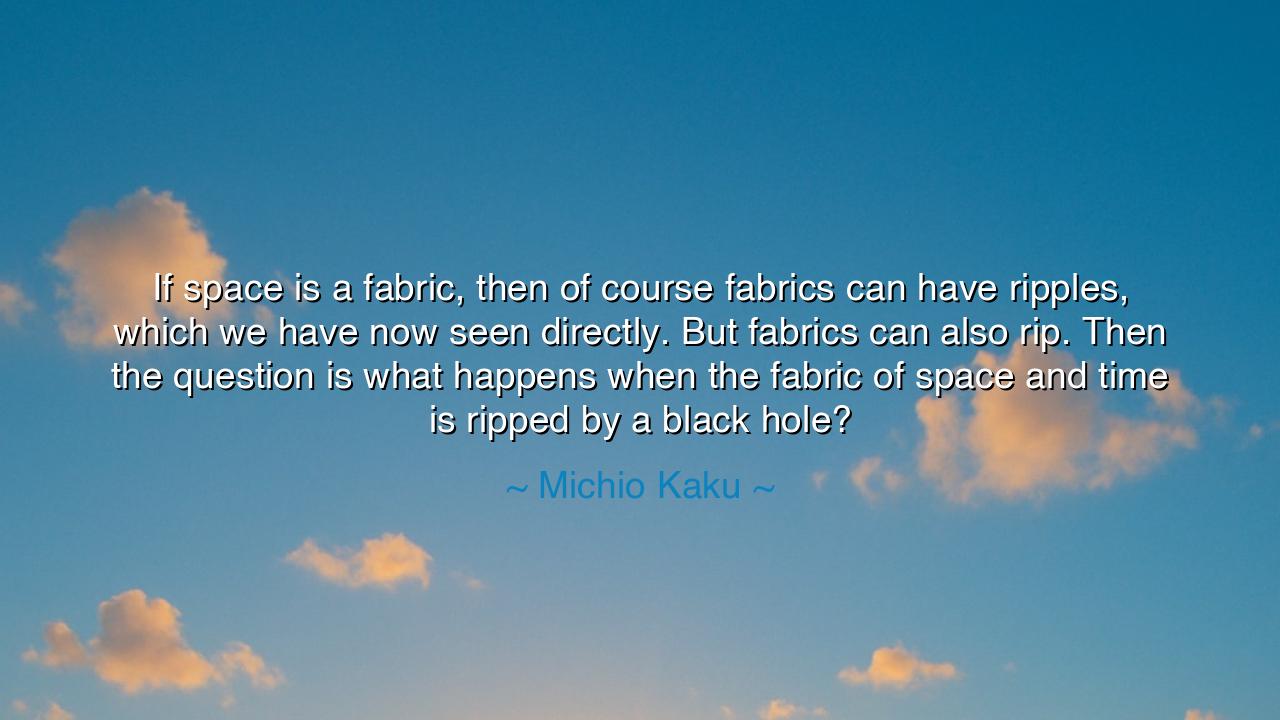
If space is a fabric, then of course fabrics can have ripples
If space is a fabric, then of course fabrics can have ripples, which we have now seen directly. But fabrics can also rip. Then the question is what happens when the fabric of space and time is ripped by a black hole?






Michio Kaku, visionary of the cosmos and interpreter of mysteries, proclaimed: “If space is a fabric, then of course fabrics can have ripples, which we have now seen directly. But fabrics can also rip. Then the question is what happens when the fabric of space and time is ripped by a black hole?” These words carry the weight of awe and wonder, for they point not only to discoveries of science but to the eternal human quest to peer beyond the veil of the known. Like the sages of old who gazed at the stars with naked eyes, Kaku gazes with instruments of modern power, yet his voice trembles with the same ancient awe: that the universe is vaster, stranger, and more fragile than we dare to imagine.
The idea of space as a fabric is born of Einstein’s general theory of relativity. Space and time, once thought of as a stage upon which matter moves, are themselves woven into a living, dynamic whole. Massive bodies bend this fabric, giving rise to what we call gravity. And when cataclysmic forces—colliding stars, merging black holes—shake this fabric, they send forth ripples across the cosmos. These ripples, known as gravitational waves, were long a dream, a whisper of theory. Yet in our own time, men and women with patient instruments have heard them, faint tremors in spacetime itself, echoing from billions of years ago. Thus, what was once vision has become reality.
But Kaku presses further: if a fabric can ripple, it can also rip. What then? Here lies the frontier where science meets myth, where speculation brushes the hem of eternity. A black hole, that devourer of light, is the place where the known laws of physics shatter, where the very geometry of existence collapses. If the fabric of spacetime were torn, what might lie beyond? Another universe? A void without law? Or some hidden dimension where the rules are unlike anything we know? Such questions are not idle; they are the very heartbeat of humanity’s desire to understand.
The ancients, too, pondered the rending of the world. When Krakatoa erupted in 1883, the island tore itself apart, and people thought the end of days had come, as the skies turned blood-red and ash circled the globe. Yet out of that destruction came renewal: new lands formed, new life emerged. In this we see a mirror to Kaku’s words. A rip in the fabric is terrifying, but it may also reveal new realms, new beginnings. Just as old worlds perish and new ones rise, perhaps the rending of spacetime is not an end but a passage.
Thus, the quote carries both fear and promise. It reminds us that what seems solid—the earth beneath us, the laws of physics, even the stars above—is in truth fragile, shifting, subject to forces beyond imagination. Yet it also stirs us to courage. For though the fabric may ripple, though it may even tear, the human spirit does not cower. We are the race that asks questions even at the edge of annihilation. We are the seekers who yearn not only to live, but to know.
O children of tomorrow, do not shrink from the vastness of these mysteries. Rather, let them kindle within you both humility and resolve. Humility, for we walk upon a universe whose foundations may tremble. Resolve, for it is given to us to explore, to wonder, to press forward even when the path ends in shadow. For every black hole that terrifies us may also be a gateway to knowledge undreamt.
The lesson is this: embrace the unknown. Do not fear the ripples that disturb your life, nor the rips that tear your certainties apart. For just as scientists who once doubted now listen to the music of gravitational waves, so too may your own struggles reveal truths unseen. The universe is a fabric—fragile, beautiful, shifting. Guard it, honor it, explore it. And when it rips, as all things must, step forward with courage, for beyond the tear may lie a new creation.
Thus the words of Michio Kaku stand as both prophecy and challenge: the fabric of spacetime trembles and may rend, but the flame of human curiosity burns brighter still. And it is this flame that must never be extinguished, for it lights the way through the darkness of eternity.






AAdministratorAdministrator
Welcome, honored guests. Please leave a comment, we will respond soon